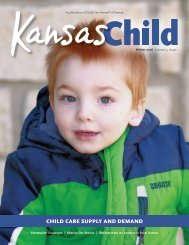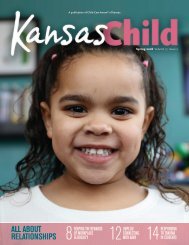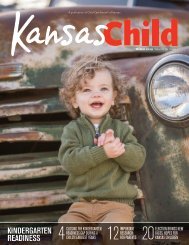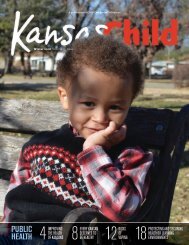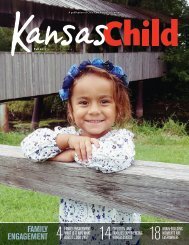2021Winter KansasChild_Final (3)
Create successful ePaper yourself
Turn your PDF publications into a flip-book with our unique Google optimized e-Paper software.
Building Blocks and Bumble Bees:
Science as the ABCs
BY MEG RICHARD
Studies have long shown that the foundations
laid in the early childhood years pave the way for
the learning ahead. I’ve often said that Preschool
and early ed teachers are the smartest and trickiest
teachers our students will ever have. Just think
of all the concepts to the tune of “ABCD,” “Baa
baa black sheep,” etc., It’s brilliance! When approaching
science with our littlest learners, many
of the same strategies apply! What might seem
like small steps can be giant leaps for our little
learners. Over time, it’s these small steps that help
our students make sense of the world — so let’s
start with some ABC’s of Science learning!
Attention and Attitude:
When using science in the early education
classroom we want to support the way students
pay attention to the world around them. Much
of this can be accomplished using materials that
likely already are being used in classrooms and
play. A recent British report noted that more children
could recognize the McDonald’s restaurant
logo than they could a bumble bee or an oak leaf.
Why? Is it because there are more McDonald’s
than bumble bees? Absolutely not! It’s all about
our attention and attitudes. Our students start to
recognize McDonald’s and associate it with the
meal, the toy and the joy! So, how can we bring
the same joy about the natural world? It could be
as simple as taking that step and going for a walk.
Idea for the classroom:
• Acorns: Acorns come from oak trees. Have students
go on a nature walk and find an acorn and
start asking questions! Where did they come
from? How do we know? Why do they have
funny hats? It is OK not to have all the answers
to your little learner’s questions. In science, we
don’t have all the answers. Part of the fun could
be in the stories you create.
B is for Budding:
Budding questions lead to building brains —
and we are in luck because science is all about
questions! When thinking about how to best support
our wee wonderers, one of the best strategies
is supporting their questions and helping them to
realize the fun in figuring it out! In a classroom,
this might look like providing something interesting
for students to look at (a butterfly chrysalis,
lights blinking in a certain pattern, or a plant bud
that over time will change into a bloom).
Idea for the classroom:
• Bumble Bees: Get excited when you see a bee. Remember,
an important part in this process is our attitude!
Sometimes when we are afraid of something
it is because we don’t understand it. Bees can be a
great opportunity to discuss respecting nature and
how important it is to us (bees pollinate the food we
eat). Consider singing, “I’m bringing home my baby
bumble bee” to ease concerns, and then talking about
the patterns we see on their bodies, comparing them
to other bugs or even having a honey celebration! The
goal is to get learners excited about what they see and
then have them make connections. Remember to be
careful and respectful around bees to avoid stings.
C is for Creativity:
For too long science has been thought of as
concepts and chemistry. But, what about creativity?
When we think of science concepts and we
look at multiple areas of science we notice that
the same pieces keep emerging as tools to help
us make sense of the world. We call these the
cross-cutting concepts! Cross-cutting concepts
are a great tool to use while looking at the world
and wondering and helping students draw connections.
When it comes to creativity, science is
everywhere, and the cross-cutting concepts help
to make connections. For example, while walking,
look up!
Idea for the classroom:
• Clouds: Clouds are a great
opportunity for kids
to get creative. Any
time you are outside
take a moment
to look
at the clouds.
What shapes
can we see or
imagine in them?
Is there a pattern
to their color and
what it feels like outside?
Do they always move
the same way, and where might
they be going?
MEG RICHARD
K-12 Science Education
Program Consultant,
KS Dept. of Education
Meg Richard is the K-12
Science Education Program
Consultant for the Kansas
Department of Education. Meg had
been teaching middle school science since
2010 and joined the department in 2020. Meg
is Nationally Board Certified in EA Science and
was the 2019 Kansas State Science Awardee
for the Presidential Award for Excellence in
Mathematics and Science Teaching (PAEMST).
Meg is passionate about integrating authentic,
hands-on science experiences for students, and
at times she can’t believe she is lucky enough
to get to do the best job in the world: teach!
Connect with her on Twitter: @frizzlerichard
www.ks.childcareaware.org
13











